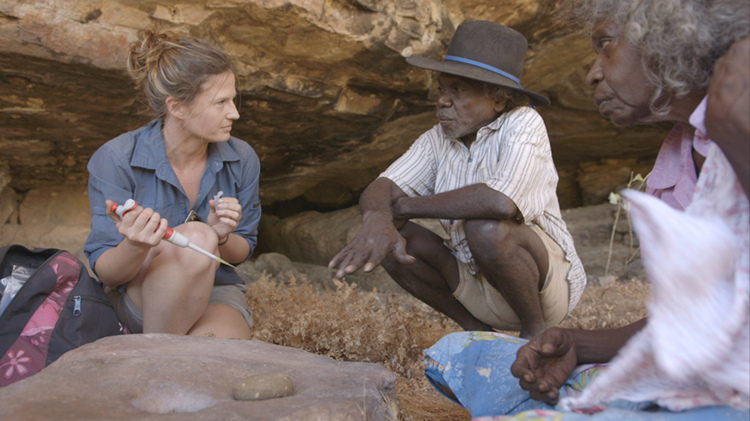New excavations conducted at Madjedbebe, a rock shelter in northern Australia, have provided evidence that humans first arrived there around 65,000 years ago. That date, based on sophisticated modern dating methods, pushes back the earliest physical evidence for human occupation in Australia by at least 15,000 years. The discovery is forcing scientists to reevaluate some common theories about the ancestors of today’s Aboriginal people of Australia.
The chronology of the peopling of Australia has been the subject of scientific debate for decades. Archaeologists have found prehistoric Aboriginal sites mainly in southern Australia. These sites—which date from 30,000 to 40,000 years ago—include locations at the Swan River in Western Australia and at Lake Mungo, Lake Tandou, and Talyawalka Creek in New South Wales. After Aboriginal people arrived in northern Australia, it could have taken them several thousand years to travel across the continent and learn to live in new environments. Scientists have therefore concluded that human beings must have arrived in northern Australia well before 40,000 years ago, the dates of the earliest Aboriginal sites in the south. Most archaeologists believed people first arrived in northern Australia in a single migration that occurred at least 50,000 years ago.

Researcher Elspeth Hayes, left, discusses the sampling of stone tool residue with Mark Djandjomerr, center, and May Nango, right, of the Mirarr Clan, the traditional owners of Madjedbebe. Credit: © Vincent Lamberti, Gundjeihmi Aboriginal Corporation
Madjedbebe, a prehistoric rock shelter about 180 miles (300 kilometers) east of Darwin in Australia’s Northern Territory, was first investigated by archaeologists in the 1970’s. The scientists discovered hundreds of stone tools at the site and many pieces of red ocher, a soft mineral often used as a pigment (coloring agent). Determining the age of the site, however, proved difficult. Beginning in 2012, archaeologists obtained permission from local Aboriginals to reenter Madjedbebe. The archaeologists then recovered more stone tools and huge amounts of red ocher. The tools included advanced ground-edge stone axes, grindstones for processing seeds, finely made stone spearpoints, and flakes of shiny mica that may have been added to ocher like glitter.
The scientists at Madjedbebe used a state-of-the-art dating technique called optically stimulated luminescence (OSL) to date the stone tool-bearing sediments. This method determines how long sediments have been buried based on the amount of electrons given off by radioactive elements that become trapped in sediment crystals. The new tests determined the sediments were between 60,000 to 70,000 years old.
Although many archaeologists were excited about the new ancient dates for this site, other scientists raised questions that had not been considered before. In an earlier study, scientists analyzing genetic material from living Aboriginal people suggested that the first humans arrived about 50,000 years ago. The genetic data suggest that the people who inhabited Madjedbebe may have been part of an early migration that was overwhelmed by later arrivals. These later migrants, they argue, are the ancestors to today’s Aboriginal people of Australia, and the earlier arrivals may have died out.
Untitled Document Can't view the linked articles? Subscribe to World Book Online

World Book Online delivers a progressive sequence of core databases supported by supplemental
tools, such as language translation, graphic organizers, and unique Webquests. Moving from
Early World of Learning to World Book Advanced, World Book Online aligns end-users with their
appropriate learning levels. Each stand-alone site provides additional features to support the
needs of users’ specific capabilities.
The World Book Difference
World Book combines cutting-edge technology with traditional editorial excellence to produce
authoritative, trustworthy, and unbiased content. The digital content is updated in real time and
carefully curated for each learning level. Accessible 24/7, the content is available on a variety of devices.
World Book Online combines 21st-century instructional techniques with timely information.
By breaking down complex topics and using easily understandable text, World Book Online helps to
build fluency and increase comprehension. Featuring single sign-on capability, these sites are paired
with highly visual content to engage even the most reluctant reader. Our collection of resources kindles
a lifelong learning experience for every user. This adherence to clarity, currency, and accuracy makes
World Book’s digital offerings an information hub for the classroom, library, and beyond.